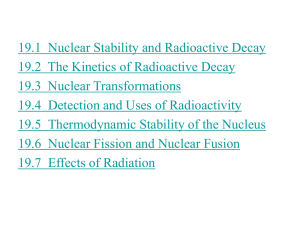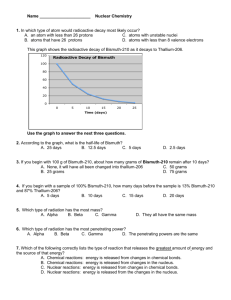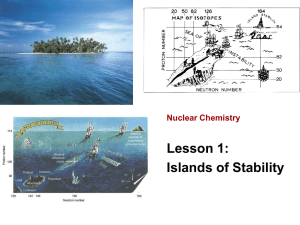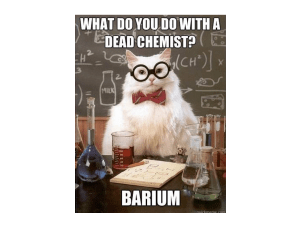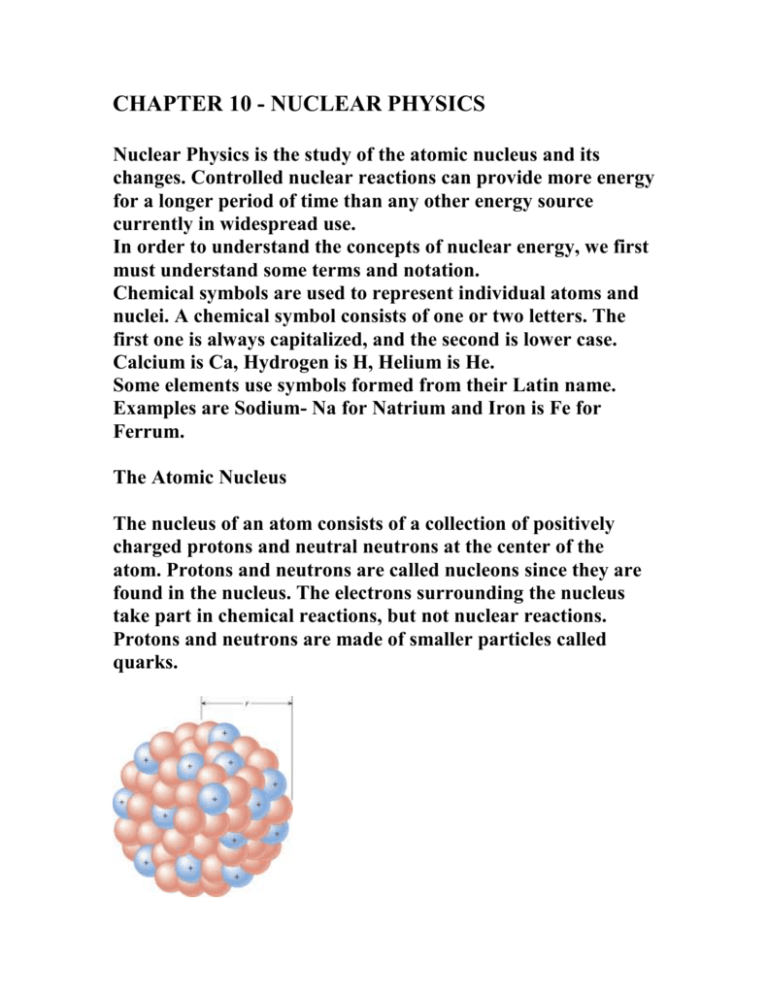
CHAPTER 10 - NUCLEAR PHYSICS
Nuclear Physics is the study of the atomic nucleus and its
changes. Controlled nuclear reactions can provide more energy
for a longer period of time than any other energy source
currently in widespread use.
In order to understand the concepts of nuclear energy, we first
must understand some terms and notation.
Chemical symbols are used to represent individual atoms and
nuclei. A chemical symbol consists of one or two letters. The
first one is always capitalized, and the second is lower case.
Calcium is Ca, Hydrogen is H, Helium is He.
Some elements use symbols formed from their Latin name.
Examples are Sodium- Na for Natrium and Iron is Fe for
Ferrum.
The Atomic Nucleus
The nucleus of an atom consists of a collection of positively
charged protons and neutral neutrons at the center of the
atom. Protons and neutrons are called nucleons since they are
found in the nucleus. The electrons surrounding the nucleus
take part in chemical reactions, but not nuclear reactions.
Protons and neutrons are made of smaller particles called
quarks.
Initially, scientists believed that atoms were composed of
spheres of positive matter with electrons dotted in them like a
plum pudding. Rutherford discovered the existence of the
nucleus during experiments with alpha particles and gold foil.
During his experiments most of the alpha particles passed
through the foil with their paths unaffected. A few, however,
acted as though they were bouncing off of a solid surface.
This led him to a form of our current picture of atomic
structure, a small dense nucleus composed of positive matter
with electrons orbiting it.
The nucleus of an atom is described using atomic number(Z),
mass number(A) and neutron number(N).
The atomic number is equal to the number of protons in the
nucleus and determines the identity of the atom. In a neutral
atom, the number of electrons equals the number of protons
and is also equal to Z. If electrons are gained or lost the
resulting particle is an ion of that element.
If protons are gained or lost through nuclear reactions, we say
we have formed a different element.
The mass number is the total number of nucleons in the atom
and the neutron number is the number of neutrons in the
atom.
These numbers are related by the equation:
A=Z+N
If we know two of these numbers we can find the third.
Atoms that have the same number of protons but different
numbers of neutrons are called isotopes.
Isotopes of an element undergo the same chemical reactions
since the electron structure is the same, but have different
atomic mass numbers. This causes some of their physical
properties, such as density, to be different.
As an example, look at the three isotopes of Hydrogen. They
are called Protium, Deuterium, and Tritium.
Three Isotopes of Hydrogen
In naturally occurring Hydrogen - 1 atom in 6000 is
deuterium and 1 in 10,000,000 is tritium. Heavy water = D2O
Copyright © Houghton Mifflin Company. All rights reserved.
Section 10.2
10 | 19
They all have one proton and one electron. Protium has no
neutrons and a mass number of 1.
Deuterium has 1 neutron for a mass number of 2.
Tritium has 2 neutrons for a mass number of 3.
Chemically they are identical. Deuterium Oxide can even be
found in water(H2O and D2O). You probably drank some
today. D2O is called heavy water because its molecular weight
is 20 compared to normal water at 18.
Tritium is radioactive.
The atomic weights on the Periodic table are weighted
averages of these masses based on Carbon – 12.
Since the nucleus is composed of only positive protons and
neutral neutrons, we expect a strong repulsive force that would
break the nucleus apart. This doesn’t happen for most
nuclei(stable) because of the strong nuclear force.
This is a very strong short range force. Only adjacent nucleons
exert it on each other. The electromagnetic repulsive force is
long range and all the protons in the atom affect each other.
When the nucleus becomes very large(Z > 83), the repulsive
force causes part of the nucleus to be expelled and we say the
nucleus is unstable(undergoes radioactive decay).
The three types of radioactive decay are (1) alpha, (2) beta, and
(3) gamma.
Alpha rays consist of particles containing 2 protons and 2
neutrons. They are the weakest form of nuclear radiation and
can be stopped by a few sheets of paper.
Beta rays consist of electrons ejected by the nucleus. Although
electrons are not found in the nucleus, the decay of a neutron is
thought to produce a proton and an electron which can be
ejected from the nucleus as a beta particle. Beta rays are more
penetrating than alpha rays and can be stopped by an inch or
two of wood.
Gamma rays consist of high energy electromagnetic radiation.
They have no mass and are similar to X-rays. They have a
higher frequency and more energy than X-rays. Exposure to
gamma radiation causes most of the deaths in a nuclear
explosion. They are stopped by several feet of concrete or a few
inches of lead.
Three Components of Radiation
from Radionuclides
Alpha(), Beta(), Gamma()
Copyright © Houghton Mifflin Company. All rights reserved.
Section 10.3
10 | 35
During the radioactive decay process, not all of the nuclei
decay at the same time. The time required for half of a sample
to decay is called its half-life. For example, thorium-234 has a
half-life of 20 days. If we start with 100 grams, at the end of 20
days, 50 grams will be left and we will have 50 grams of the
daughter nucleus, palladium. In another 20 days we will have
25 grams of thorium-234 and an additional 25 grams of
palladium.
Decay of Thorium-234 over Two Half-Lives
Thorium-234 has a Half-Life of 24 days
Copyright © Houghton Mifflin Company. All rights reserved.
Section 10.3
10 | 45
Example
A 40 g sample of iodine-131(half-life = 8 days) decays for 24
days. How many grams are left?
Nuclear Reactions
Transmutation is the process of a nucleus changing into
another nucleus. This can happen spontaneously, as in
radioactive decay, or it can happen artificially when scientists
add particle(s) to a nucleus causing it to change.
All of the elements with atomic numbers greater than 92 are
created artificially and do not exist in nature. They are called
transuranium elements.
Radioactive isotopes are called radionuclides. They are useful
as tracers in medicine, agriculture, and other fields. They can
be used for cancer treatment, in smoke detectors, and in
radioactive dating.
Smoke Detector
• A weak radioactive source ionizes the air and sets up
a small current. If smoke particles enter, the current
is reduced, causing an alarm.
Copyright © Houghton Mifflin Company. All rights reserved.
Section 10.4
10 | 67
Nuclear Fission
Fission is the process of splitting a large atom into two
relatively equal parts with the conversion of matter into energy
and the release of two or more neutrons.
In the case of Uranium-235, when a neutron is added to form
Uranium-236, the nucleus may split into Xenon-140 and
Strontium-94 plus 2 neutrons. Notice that the mass numbers
add up although a small amount of matter is converted into
energy.
Other reaction products are possible such as Krypton-92 and
Barium-141 plus 3 neutrons.
These fission products are always radioactive. Some have halflives of hundreds or thousands of years. They must be stored
safely for extremely long periods of time.
In a nuclear reactor or a fission bomb, these neutrons
produced by fission reactions can be captured by other
Uranium-235 atoms to make those undergo fission. If this
process happens over and over, we call it a chain reaction. If
the chain reaction occurs too rapidly, we have a rapid release
of energy and a nuclear explosion. If we slow the chain reaction
so that each reaction produces just one more, we have a
controlled self-sustaining reaction.
The minimum amount of a fissionable material required to
create a self sustaining chain reaction is called a critical mass
which for Uranium-235 is about 4.0 kg, a volume the size of a
baseball.
Naturally occurring Uranium is only about 0.70% U-235, so it
must be enriched (concentrated) to be used. In a nuclear
reactor, the Uranium is only about 3.0% U-235. To make a
nuclear bomb, the Uranium must be about 90% or better U235. Nuclear reactors will not produce a nuclear explosion,
only a chemical explosion.
In a nuclear reactor, uranium oxide pellets are placed in fuel
rods which are inserted into the core, the central part of the
reactor. Control rods, which absorb neutrons and slow down
the chain reaction, are inserted, too. These control rods can be
adjusted to speed up, slow down, or even stop the reaction.
In the United States, most operating reactors are called
swimming pool reactors because the core is immersed in water.
The water takes heat away from the core and can be used to
drive steam turbines to produce electricity. The water also acts
as a moderator. It slows neutrons down so that they are more
easily captured by the U-235 atoms.
Nuclear Reactor
Note that the
hot water
circuit is
completely
“contained,”
thereby
allowing no
radioactive
contamination.
Hot water
circuit
Section 10.5
If the heat is not removed quickly enough, the temperature of
the core can rise to the point that a meltdown occurs. When
this happens, the temperatures get so high that the rods in the
core become fused and melt through the floor of the
containment vessel and building, contaminating the external
environment. This is where the term and movie China
Syndrome came from(melt all the way to China).
At Three Mile Island in Pennsylvania, a partial meltdown
occurred. Only a small amount of radioactive gasses escaped
from the containment building.
At Chernobyl in the Soviet Union, however, operators testing
the reactor shut off several vital emergency safety systems.
They lost controll and could not stop a complete meltdown.
This reactor used graphite(carbon) as a moderator. When the
meltdown occurred, the graphite caught on fire and ignited
some of the gasses produced by the reaction. The resulting
explosion spread radiation across a large part of Europe.
Another fissionable isotope, Plutonium-239 is produced from
U-238 by fast neutrons. In a breeder reactor, this process is
enhanced and Pu-239 is produced in relatively large quantities.
Breeder reactors are commonly used in France and Germany.
The danger is that the Pu-239 is relatively easy to separate and
purify using chemical reactions. It is much easier to produce
weapon grade Pu-239 than U-235.
Nuclear Fusion
Fusion is the process of smaller atoms combining to form
larger ones with a release of energy. As in fission, the energy is
produced when some of the matter in the reactants is
converted to energy. This matter is called the nuclear mass
defect. The energy produced can be calculated using Einstein's
equation E = mc2.
Below is an example of a fusion reaction.
Fusion reactions are difficult to initiate and even more difficult
to maintain. In stars, like the sun, fusion occurs because
temperatures and pressures are so high(100 million K). At
these temperatures matter exists as a plasma(a gas composed
of electrons and nuclei, no atoms or molecules). On the earth, it
is possible to reach temperatures high enough, but not in a
controlled situation.
Thermonuclear bombs use the fusion process to develop the
enormous amounts of energy they release, but in an
uncontrolled manner.
Research into fusion as a controlled power source continues.
One group even reported recently that they had produced a
sustainable fusion reaction at temperatures close to room
temperature(cold fusion) but they were eventually discredited.
Biological Effects of Radiation
Radioactivity is not new in our environment. Before nuclear
bombs, reactors, X-rays and other manmade sources of
radiation were developed, radiation was present from sources
like Radon, radioactive deposits, solar radiation and even
radioactive isotopes of naturally occurring elements(C-14).
Radiation that is strong enough to knock electrons out of
atoms or molecules is called ionizing radiation. This type of
radiation can damage or kill cells or cause changes in the DNA
of cells.
You cannot sense ionizing radiation or the damage it is doing.
It does, however, affect photographic film so radiation
detection badges contain some of this film.
There are two main categories of radiation effects.
1. Somatic Effects - damaging changes in the cells and/or
tissues of the recipient(radiation burns, sickness, hair falling
out, etc.)
2. Genetic Effects - changes in the recipient's reproductive
DNA so that offspring are affected(not in a good way).
Radiation doses are measured in rads(radiation absorbed dose)
where 1 rad is 0.01 j per kg of tissue.
Since different types of radiation interact with tissue
differently, the unit of biological effects of radiation is the
rem(roentgen equivalent for man). It takes into account both
the amount of radiation and the differences in the damage per
rad.
Most people receive about 0.2 rem of background radiation
each year. It comes from Radon, medical X-rays, Nuclear
medicine, TV sets and computer monitors, Cosmic rays, Soil
and rocks, and some substances within the body such as C-14.
Sources of Exposure to Radiation
• 0.2 rem –
average
annual
radiation
exposure for
person in
U.S.
Copyright © Houghton Mifflin Company. All rights reserved.
Section 10.7 10 | 111
Effects of a Single Dose of Whole-Body Radiation
0 - 25 rem
No detectable effects
25 - 100 rem
Temporary decrease in white cell count
100 - 200 rem Vomiting, loss of hair(mild radiation sickness)
200 - 600 rem Radiation sickness, hemorrhaging
600+ rem
Death
As far as genetic effects, exposure limits are not known.
Because of this uncertainty, women who may be pregnant are
not intentionally exposed to X-rays or other forms of ionizing
radiation.
P280 Study Key Terms, Matching, Multiple Choice and Fill-inthe-Blank Questions
P 281 Answer Questions 1, 3, 4, 5, 6, 10, 11, 15, 16, 17, 18, 23,
25, 27, 31, 35, 38
P 282 Applying Your Knowledge 2
P 282 Exercises 1, 9

